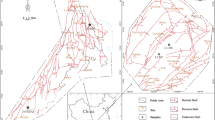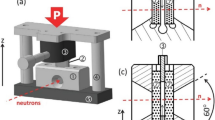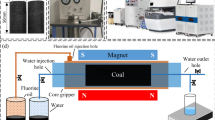Abstract
Coal pores and fractures vary in geometric structure, size distribution, and compressibility in different directions, referred to as the anisotropy of coal pores and fractures (APF). For high-dip coal seams, this anisotropy impacts coal reservoirs more severely owing to stress variations. A low-field nuclear magnetic resonance (NMR) test can detect the pore size distribution under different confining pressures. By changing the angle between the axis of the columnar sample and the coal bedding plane, the NMR test could express the evolution of the APF with stress. Pressurized NMR tests were performed to extrapolate the variation in the pore size distribution and compressibility with the dip angle. T2 spectra of each columnar sample were divided into two peaks (P1 and P2) with T2 = 2.5 ms as the boundary. By establishing a linear elastic model, the pore size distribution of P1 can be regarded as a superposition of the micropore deformation controlled by APF. Based on the predominant orientation of the pore structure, the anisotropy of the micropores was created before the formation was tilted. Most (80.1%, volume percentage) of the micropores had geometric spindles parallel to the bedding plane, and most were ellipsoids. Through stress and spectral analyses, we found that the seepage fractures were mostly (80.45%, volume percentage) occupied by the cleat system perpendicular to the bedding plane. The fracture compressibility was related to the normal stress received. The dip angle decomposed the confining pressure in the coalbed and changed its compressibility. As the pressure increased, the multi-scale effect narrowed the main fracture, but did not change other fractures, which reduced the anisotropy of fracture.















Similar content being viewed by others
References
Cao, Y. J., Shen, W. Q., Shao, J. F., & Burlion, N. (2018). Influences of micro-pores and meso-pores on elastic and plastic properties of porous materials. European Journal of Mechanics A-Solids, 72, 407–423.
Chen, S., Tang, D., Tao, S., Ji, X., & Xu, H. (2019). Fractal analysis of the dynamic variation in pore-fracture systems under the action of stress using a low-field NMR relaxation method: An experimental study of coals from western Guizhou in China. Journal of Petroleum Science and Engineering, 173, 617–629.
Coates, G. R., Xiao, L., & Prammer, M. G. (1999). NMR logging principles and applications. Gulf Publishing Company.
Gao, Z., Li, B. B., Li, J. H., Wang, B., Ren, C. H., Xu, J., & Chen, S. (2021). Coal permeability related to matrix-fracture interaction at different temperatures and stresses. Journal of Petroleum Science and Engineering, 200, 108428.
Geng, Y. G., Tang, D. Z., Xu, H., Tao, S., Tang, S. L., Ma, L., & Zhu, X. G. (2017). Experimental study on permeability stress sensitivity of reconstituted granular coal with different lithotypes. Fuel, 202, 12–22.
Gu, F., & Chalaturnyk, R. (2010). Permeability and porosity models considering anisotropy and discontinuity of coalbeds and application in coupled simulation. Journal of Petroleum Science and Engineering, 74(3–4), 113–131.
Harpalani, S. (1999). Compressibility of coal and its impact on gas production from coalbed reservoirs. Rock Mechanics for Industry, 1 and 2, 301–308.
Hu, X., & Cai, J. (2020). Research on the first breaking mechanism of the main roof of coal seam with high dip angle. Advances in Civil Engineering, 2020, 8820625.
Kang, J. Q., Fu, X. H., Liang, S., Li, X., Chen, X., & Wang, Z. Z. (2019). A numerical simulation study on the characteristics of the gas production profile and its formation mechanisms for different dip angles in coal reservoirs. Journal of Petroleum Science and Engineering, 181, 106198.
Latour, L. L., Kleinberg, R. L., & Sezginer, A. (1992). Nuclear-magnetic-resonance properties of rocks at elevated-temperatures. Journal of Colloid and Interface Science, 150(2), 535–548.
Li, G., Yan, D., Zhuang, X., Zhang, Z., & Fu, H. (2019a). Implications of the pore pressure and in situ stress for the coalbed methane exploration in the southern Junggar Basin, China. Engineering Geology, 262, 105305.
Li, S., Tang, D., Pan, Z., Xu, H., & Huang, W. (2013). Characterization of the stress sensitivity of pores for different rank coals by nuclear magnetic resonance. Fuel, 111, 746–754.
Li, X., Fu, X. H., Ranjith, P. G., & Xu, J. (2019b). Stress sensitivity of medium- and high volatile bituminous coal: An experimental study based on nuclear magnetic resonance and permeability-porosity tests. Journal of Petroleum Science and Engineering, 172, 889–910.
Liu, S. M., & Harpalani, S. (2014). Determination of the effective stress law for deformation in coalbed methane reservoirs. Rock Mechanics and Rock Engineering, 47(5), 1809–1820.
Liu, Y., Tang, D., Xu, H., Li, S., Zhao, J., & Meng, Y. (2015). Characteristics of the stress deformation of pore-fracture in coal based on nuclear magnetic resonance. Journal of China Coal Society, 40(6), 1415–1421.
Liu, Z. S., Liu, D. M., Cai, Y. D., Yao, Y. B., Pan, Z. J., & Zhou, Y. F. (2020). Application of nuclear magnetic resonance (NMR) in coalbed methane and shale reservoirs: A review. International Journal of Coal Geology, 218, 103261.
Okolo, G. N., Everson, R. C., Neomagus, H. W. J. P., Roberts, M. J., & Sakurovs, R. (2015). Comparing the porosity and surface areas of coal as measured by gas adsorption, mercury intrusion and SAXS techniques. Fuel, 141, 293–304.
Pan, Z., & Connell, L. D. (2012). Modelling permeability for coal reservoirs: A review of analytical models and testing data. International Journal of Coal Geology, 92, 1–44.
Sander, R., Pan, Z., & Connell, L. D. (2017). Laboratory measurement of low permeability unconventional gas reservoir rocks: A review of experimental methods. Journal of Natural Gas Science and Engineering, 37, 248–279.
Tan, Y., Pan, Z., Liu, J., Zhou, F., Connell, L. D., Sun, W., & Haque, A. (2018). Experimental study of impact of anisotropy and heterogeneity on gas flow in coal Part II: Permeability. Fuel, 230, 397–409.
Tang, S., Liu, S., Tang, D., Tao, S., Zhang, A., Pu, Y., & Zhang, T. (2021). Occurrence of fluids in high dip angled coal measures: Geological and geochemical assessments for southern Junggar Basin, China. Journal of Natural Gas Science and Engineering, 88, 103827. https://doi.org/10.1016/j.jngse.2021.103827
Tao, S., Chen, S., Tang, D., Zhao, X., Xu, H., & Li, S. (2018). Material composition, pore structure and adsorption capacity of low-rank coals around the first coalification jump: A case of eastern Junggar Basin, China. Fuel, 211, 804–815.
Tao, S., Pan, Z., Chen, S., & Tang, S. (2019a). Coal seam porosity and fracture heterogeneity of marcolithotypes in the Fanzhuang Block, southern Qinshui Basin, China. Journal of Natural Gas Science and Engineering, 66, 148–158. https://doi.org/10.1016/j.jngse.2019.03.030
Tao, S., Pan, Z., Tang, S., & Chen, S. (2019b). Current status and geological conditions for the applicability of CBM drilling technologies in China: A review. International Journal of Coal Geology, 202, 95–108.
Wang, D., Lv, R., Wei, J., Zhang, P., Yu, C., & Yao, B. (2018). An experimental study of the anisotropic permeability rule of coal containing gas. Journal of Natural Gas Science and Engineering, 53, 67–73.
Wang, H., Zhang, X., Zhang, S., Huang, H., & Wang, J. (2021b). Numerical simulation research on well pattern optimization in high-dip angle coal seams: A case of Baiyanghe Block. Frontiers in Earth Science, 9, 692619. https://doi.org/10.3389/feart.2021.692619
Wang, K., Zang, J., Wang, G. D., & Zhou, A. T. (2014). Anisotropic permeability evolution of coal with effective stress variation and gas sorption: Model development and analysis. International Journal of Coal Geology, 130, 53–65.
Wang, Z., Wang, H., Yang, Y., Deng, Z., Fu, X., Pan, J., & Kang, J. (2021a). Effect of the coal molecular structure on the micropore volume and the coalbed methane content. Energy & Fuels, 35(23), 19437–19447.
Yang, S., Cai, Y., Wei, R., & Zhou, Y. (2019a). A new fracture permeability model of CBM reservoir with high-dip angle in the southern Junggar Basin, NW China. Energy Exploration & Exploitation, 37(1), 125–143. https://doi.org/10.1177/0144598718807552
Yang, Z., Peng, H., Zhang, Z., Ju, W., Li, G., & Li, C. (2019b). Atmospheric-variational pressure-saturated water characteristics of medium-high rank coal reservoir based on NMR technology. Fuel, 256, 115976.
Yao, Y. B., Liu, D. M., Che, Y., Tang, D. Z., Tang, S. H., & Huang, W. H. (2010). Petrophysical characterization of coals by low-field nuclear magnetic resonance (NMR). Fuel, 89(7), 1371–1380.
Yao, Y. B., Liu, D. M., Liu, J. G., & Xie, S. B. (2015). Assessing the water migration and permeability of large intact bituminous and anthracite coals using NMR relaxation spectrometry. Transport in Porous Media, 107(2), 527–542.
Zang, J., Ge, Y., & Wang, K. (2020). The principal permeability tensor of inclined coalbeds during pore pressure depletion under uniaxial strain conditions: Developing a mathematical model, evaluating the influences of featured parameters, and upscaling for CBM recovery. Journal of Natural Gas Science and Engineering, 74, 103099.
Zhang, J., Wei, C., Ju, W., Yan, G., Lu, G., Hou, X., & Kai, Z. (2019). Stress sensitivity characterization and heterogeneous variation of the pore-fracture system in middle-high rank coals reservoir based on NMR experiments. Fuel, 238, 331–344.
Zhang, T., Tao, S., Tang, D., Tang, S., Xu, H., Zhang, A., Pu, Y., Liu, Y., & Yang, Q. (2021). Permeability anisotropy in high dip angle coal seam: A case study of southern Junggar Basin. Natural Resources Research, 30(3), 2273–2286.
Zhao, J., Xu, H., Tang, D., Mathews, J. P., Li, S., & Tao, S. (2016). A comparative evaluation of coal specific surface area by CO2 and N-2 adsorption and its influence on CH4 adsorption capacity at different pore sizes. Fuel, 183, 420–431.
Zhao, P., Zhuo, R., Li, S., Shu, C. M., Jia, Y., Lin, H., Chang, Z., Ho, C. H., Laiwang, B., & Xiao, P. (2021). Fractal characteristics of methane migration channels in inclined coal seams. Energy, 225, 120127.
Zimmerman, R. W., Somerton, W. H., & King, M. S. (1986). Compressibility of porous rocks. Journal of Geophysical Research-Solid Earth and Planets, 91(B12), 12765–12777.
Acknowledgments
This research was financially supported by the National Natural Science Foundation of China (Grant Nos. 42102205, 42130802, 42272200).
Author information
Authors and Affiliations
Corresponding author
Ethics declarations
Conflict of Interest
The authors declare that there is no conflict of interests regarding the publication of this paper.
Appendices
Appendix
Settings of the Ellipsoid Model
Physical Setting
The space in the cylinder, except for the ellipsoid, was regarded as the coal matrix. Considering the matrix as a linear elastic formula material, based on the generalized Hooke’s law, we have:
where \({\boldsymbol{\sigma}}\) is the stress, \({\boldsymbol{\varepsilon}}\) is the strain, and the angle indicates the direction; \(\nu\) is Poisson's ratio and \(E\) is Young's modulus. Under imitating laboratory conditions, pressure was applied on the side of the cylinder, and the vertical strain was limited to the two bottom surfaces, thus:
where \({P}_{c}\) denotes the confining pressure, and \({u}_{z}\) is a component of the displacement field \({\varvec{u}}\), and
The displacement field on the surface of the ellipsoid can be obtained using Eq. (17). The volume of the ellipsoid can be calculated as:
\(({V}_{0}-V)/{V}_{0}\) was used to measure the change in the pores (Eq. 11). In addition, the pore change degree per unit of confining pressure change (r) had a physical meaning similar to the linear fitting slope \(k\) in the test results (Eq. 5). The difference between \(r\) and \(k\) is that one is a measure of the deformation of a single pore and the other is a measure of the entire sample.
Parameter Setting
The calculated results were controlled mainly by the following points: the mechanical parameters of the coal matrix (Young’s modulus \(E\), Poisson’s ratio \(\nu\)), relative size of the matrix microelement (the ratio of the side length \(L\) to the major axis \(a\)), shape (eccentricity), and pore major axis inclination (\(\varphi\)).
The empirical constants for the mechanical parameters were selected and adjusted appropriately based on the test results. The relative size of the matrix microelements affects the compressibility of pores (Li et al., 2019a, 2019b). The other parameters were fixed, gradually increasing \(L/a\) and calculating the volume \(V\) after pressurization. The value of \(V\) tended to stabilize with an increase in \(L/a\) (Fig. 16). The minimum value at which \(V\) reaches stability can be used as the microelement size. The shape of the pores was controlled by the relative lengths of the three axes. To avoid the appearance of repeated shapes, \(a\ge b\ge c\) was specified. In this case, \(1\ge {e}_{ac}\ge {e}_{bc}\ge 0\). The inclination angle of the long axis of the pore affected the stress state. This inclination angle can be considered as the angle \(\varphi\) between the long axis a and horizontal plane. However, it should be noted that the inclination angle here was different from the sampling dip angle \(\theta\) in the test.
16).
Derivation of Eqs. 11 and 12
Under the experimental conditions, the confining pressure was applied only in the radial direction, and the axial direction was fixed by the core holder. Therefore, the radial strain was equal, and the axial strain was 0. The strain components expressed by the confining pressure can be obtained as:
where \({\varepsilon }_{x},{\varepsilon }_{y},{\varepsilon }_{z}\) are the 11,22,33 components of the strain tensor in the cleat coordinate system, where the xy plant is the bedding surface and the z-axis is perpendicular to the bedding plane. In this study, it was considered that the x direction represents the stress direction of the main crack (cleat), and the z direction represents the stress direction of the secondary crack. From the generalized Hooke's law, the relationship between the stress and strain can be expressed as:
Combining the above two formulas, we can get:
For volume changes,
Dividing both sides of Eq. (22) by the initial volume and pressure, the left-hand side of the equation is approximated in the form of the compressibility, thus:
Combined with the definition of volume ratio \({\xi }_{2}\) and the above formula, we get:
On the premise that the compressibility of a crack is related only to its normal stress, the following definitions
are brought into Eq. (23) to obtain:
Rights and permissions
Springer Nature or its licensor (e.g. a society or other partner) holds exclusive rights to this article under a publishing agreement with the author(s) or other rightsholder(s); author self-archiving of the accepted manuscript version of this article is solely governed by the terms of such publishing agreement and applicable law.
About this article
Cite this article
Zhang, T., Tang, S., Tang, D. et al. Measurement of Pore Distribution and Compression Anisotropy by Nuclear Magnetic Resonance. Nat Resour Res 32, 755–770 (2023). https://doi.org/10.1007/s11053-022-10155-3
Received:
Accepted:
Published:
Issue Date:
DOI: https://doi.org/10.1007/s11053-022-10155-3





